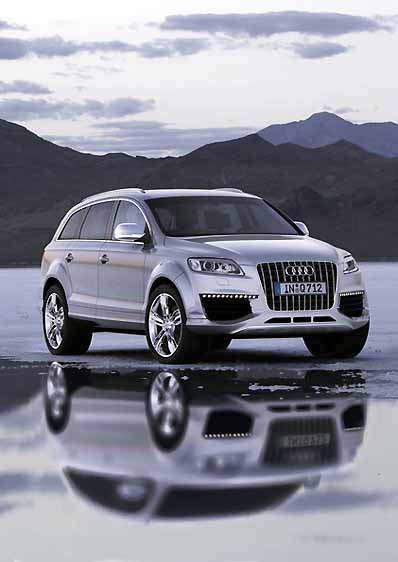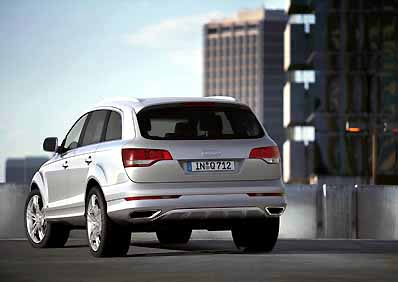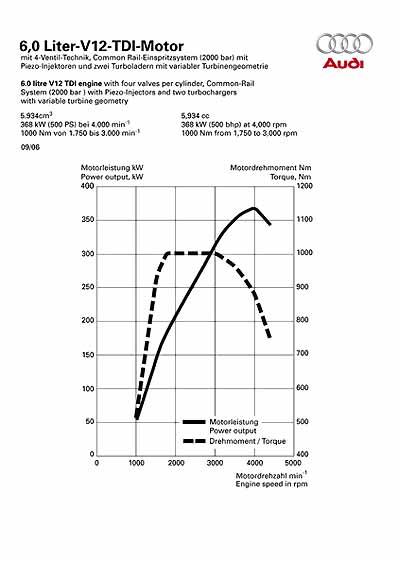
Exceptional comfort

Herausragender Komfort
 |
Twelve cylinders in the Audi Q7
Audi has stood
at the forefront of diesel technology for the last three decades. The Ingolstadt
brand now presents a further world first - the first V12 diesel engine in
a passenger car.
 The new Audi Q7 V12 TDI is powered by a twelve-cylinder diesel
engine containing a wealth of pioneering technology. With an outstanding
500 PS and 1,000 Nm of torque, the six-litre engine of the high-performance
SUV provides the driving performance of a sports car. Sprinting from 0 to
100 km/h in just 5.5 seconds and achieving an electronically governed top
speed of 250 km/h, the Audi Q7 V12 TDI is catapulted into the echelons of
top-class sports cars. New horizons have been set in the diesel market thanks
to this outstanding power. None of our competitors can offer a comparable
engine. The big performance SUV from Audi accelerates with impressive ease.
Superior power reserves in any situation are provided by the world's first
2,000 bar Bosch Common Rail system. The ultra-modern piezo-injection system
offers impressive acoustics at the highest levels of driving comfort. The
new six-speed tiptronic gearbox, which features extensive reinforcements,
shifts quickly and comfortably. It transfers the enormous power to the quattro
permanent four-wheel drive system. The new Audi Q7 V12 TDI has an average
fuel consumption of just 11.9 litres per 100 kilometres. All diesel engines
from Audi are highly dynamic thanks to their high performance and high torque
characteristics. Audi has often proved its sporty character in series production,
most recently through the six and eight-cylinder 3.0 TDI and 4.2 TDI engines.
Audi also rewrote the record books earlier this year on the racetrack. Following
its debut in Sebring, Florida, the premium R10 prototype sports car won every
long-distance race it entered. These included the Le Mans 24 Hours road race,
probably the most difficult race in the world for both man and machine. The
V12 race engine in the R10 squeezed 650 bhp from its 5.5-litre engine capacity,
reaching a top speed of 330 km/h. The power and endurance of the R10 was
an immediate hit with fans and experts alike. However, what completely surprised
them was the sound of the engine: unlike most racing engines, the powerful
Audi diesel engine runs whisper-quiet. Transferring race car technology into
series production is an Audi tradition. The FSI engine in the predecessor
to the R10, the R8, notched up five victories in Le Mans with its petrol
direct injection. Audi has already transferred FSI performance to the production
line. The most recent examples of this are the high-revving V8 in the RS
4 and the V10 FSI in the S6 and S8. The new Audi Q7 V12 TDI is powered by a twelve-cylinder diesel
engine containing a wealth of pioneering technology. With an outstanding
500 PS and 1,000 Nm of torque, the six-litre engine of the high-performance
SUV provides the driving performance of a sports car. Sprinting from 0 to
100 km/h in just 5.5 seconds and achieving an electronically governed top
speed of 250 km/h, the Audi Q7 V12 TDI is catapulted into the echelons of
top-class sports cars. New horizons have been set in the diesel market thanks
to this outstanding power. None of our competitors can offer a comparable
engine. The big performance SUV from Audi accelerates with impressive ease.
Superior power reserves in any situation are provided by the world's first
2,000 bar Bosch Common Rail system. The ultra-modern piezo-injection system
offers impressive acoustics at the highest levels of driving comfort. The
new six-speed tiptronic gearbox, which features extensive reinforcements,
shifts quickly and comfortably. It transfers the enormous power to the quattro
permanent four-wheel drive system. The new Audi Q7 V12 TDI has an average
fuel consumption of just 11.9 litres per 100 kilometres. All diesel engines
from Audi are highly dynamic thanks to their high performance and high torque
characteristics. Audi has often proved its sporty character in series production,
most recently through the six and eight-cylinder 3.0 TDI and 4.2 TDI engines.
Audi also rewrote the record books earlier this year on the racetrack. Following
its debut in Sebring, Florida, the premium R10 prototype sports car won every
long-distance race it entered. These included the Le Mans 24 Hours road race,
probably the most difficult race in the world for both man and machine. The
V12 race engine in the R10 squeezed 650 bhp from its 5.5-litre engine capacity,
reaching a top speed of 330 km/h. The power and endurance of the R10 was
an immediate hit with fans and experts alike. However, what completely surprised
them was the sound of the engine: unlike most racing engines, the powerful
Audi diesel engine runs whisper-quiet. Transferring race car technology into
series production is an Audi tradition. The FSI engine in the predecessor
to the R10, the R8, notched up five victories in Le Mans with its petrol
direct injection. Audi has already transferred FSI performance to the production
line. The most recent examples of this are the high-revving V8 in the RS
4 and the V10 FSI in the S6 and S8.
Pioneering technical
performance
 The new series-production V12 TDI, assembled in our plant in
Györ, Hungary, reaches a still outstanding level of "only" 500 bhp.
When designing the engine, it was kept in mind that the six-litre engine
would be a derivative of the current family of Audi V-engines, which up to
now were limited to six, eight and ten cylinders. The basic findings from
the race car were of course transferred to the series-production engine.
The V12 TDI aggregate has a cylinder clearance of 90 mm, which is standard
for engines of this type. Nonetheless, the engine has a cylinder angle of
60° instead of 90°, leading to an elimination of inertia in this
type of V12 design. Driving comfort is thus ensured in every situation. The
total engine capacity of 5,934 cm3 is derived from a bore measurement of
83 mm and a stroke of 91.4 mm, exactly the same as that of the 3.0 TDI. The
large diesel engine is extremely compact. Measuring 684 mm in length, it
is only 166 mm longer than the V8 TDI. These dimensions are the primary
requirement for integrating the V12 into the Audi Q7. The crankcase of the
V12 TDI is constructed from cast-iron with vermicular graphite. This high-tech
material, known as GJV-450, has already been used in the V6 and V8 models.
Produced in a patented casting procedure, GJV-450 is around 40 % more rigid
and 100 % more fatigue-resistant than grey cast iron. This allowed the developers
to reduce the wall thickness. The weight potential compared to conventional
grey cast iron is around 15 %. The crankshaft, forged from a chrome and
molybdenum steel alloy, is held by an extremely rigid main bearing bracket
made from cast iron reinforced by nodular graphite. The forged piston rods
are cracked, whilst the forged pistons are made from aluminium. Both cylinder
heads are composed of three main elements. The lower section is made from
a highly durable and light aluminium alloy where the intake and escape channels
are integrated. The upper section guides the flow of engine oil, whilst both
camshafts are stored within a reinforcing ladder frame. The valves are actuated
using low-friction roller cam followers with a compression ratio of 16:1.
The engine characteristic swirl variations of combustion air were taken from
the V6 and V8 TDI engines. The optimum swirl with respect to emissions and
simultaneous high performance can therefore be set. The new series-production V12 TDI, assembled in our plant in
Györ, Hungary, reaches a still outstanding level of "only" 500 bhp.
When designing the engine, it was kept in mind that the six-litre engine
would be a derivative of the current family of Audi V-engines, which up to
now were limited to six, eight and ten cylinders. The basic findings from
the race car were of course transferred to the series-production engine.
The V12 TDI aggregate has a cylinder clearance of 90 mm, which is standard
for engines of this type. Nonetheless, the engine has a cylinder angle of
60° instead of 90°, leading to an elimination of inertia in this
type of V12 design. Driving comfort is thus ensured in every situation. The
total engine capacity of 5,934 cm3 is derived from a bore measurement of
83 mm and a stroke of 91.4 mm, exactly the same as that of the 3.0 TDI. The
large diesel engine is extremely compact. Measuring 684 mm in length, it
is only 166 mm longer than the V8 TDI. These dimensions are the primary
requirement for integrating the V12 into the Audi Q7. The crankcase of the
V12 TDI is constructed from cast-iron with vermicular graphite. This high-tech
material, known as GJV-450, has already been used in the V6 and V8 models.
Produced in a patented casting procedure, GJV-450 is around 40 % more rigid
and 100 % more fatigue-resistant than grey cast iron. This allowed the developers
to reduce the wall thickness. The weight potential compared to conventional
grey cast iron is around 15 %. The crankshaft, forged from a chrome and
molybdenum steel alloy, is held by an extremely rigid main bearing bracket
made from cast iron reinforced by nodular graphite. The forged piston rods
are cracked, whilst the forged pistons are made from aluminium. Both cylinder
heads are composed of three main elements. The lower section is made from
a highly durable and light aluminium alloy where the intake and escape channels
are integrated. The upper section guides the flow of engine oil, whilst both
camshafts are stored within a reinforcing ladder frame. The valves are actuated
using low-friction roller cam followers with a compression ratio of 16:1.
The engine characteristic swirl variations of combustion air were taken from
the V6 and V8 TDI engines. The optimum swirl with respect to emissions and
simultaneous high performance can therefore be set.
Ultra-modern
injection technology
 Like most Audi V-engines, the maintenance-free chain drive is
located on the back of the engine in a space-saving arrangement. A new layout
is used in the new V12 TDI. The chain wheel of the crankshaft locks into
the gearwheel. From here two simplex chains drive the camshaft. Two further
chains drive the oil pump and both high-pressure pumps in the common rail
injection system. Both new double stamped high-pressure pumps are part of
the new common rail injection system developed by the specialists at Bosch.
Both pumps amass up to 2,000 bar of pressure in the rails; only 1,600 bar
was usually achieved up to now. The piezo injectors, with their eight-hole
jets, have also been radically updated. An optimal spray is created in the
combustion chamber through the high pressure. This in turn allows the ignition
process to take place quicker and more homogenously, leading to a much better
sound. The efficient combustion also improves performance whilst reducing
emissions and fuel consumption. The current generation of inline injectors
use the piezo effect. When an electric current is created, piezo crystals
expand in milliseconds. This expansion is then directly transported (inline)
by the V12 TDI injectors - containing over one hundred piezo plates - to
the injection nozzle needles without the use of mechanisms in between. The
number of injection processes per power stroke can be widely varied using
piezo technology, in the case of the V12 TDI up to five injections. In addition
to the main injection, pre and post-injections are possible. Pre-injections
reduce the acoustic hardness of the combustion procedure. Post-injections
serve to increase the temperature of the emissions, helping regeneration
of both standard-fit particulate filters. Both turbochargers can be found
on the exterior of the V-engine, each supplied with a cylinder bank. Thanks
to its adjustable guide vane geometry, the complete gas emission stream is
always fed through the turbines. The chargers respond even at low levels
of revolution and reach high levels of efficiency. Both turbochargers amass
a charge pressure of up to 2.6 bar and are a key aspect of the exceptional
torque levels of 1,000 Nm that are supplied to the V12 TDI constantly between
1,750 and 3,000 rpm. With its 368 kW (500 bhp), the diesel reaches a specific
performance of 62 kW (84.3 bhp) per litre of engine capacity. Two large charge
air coolers reduce the temperature of the compressed air. The V12 comes with
a double-flow exhaust system with two particulate filters. The suction unit
is built in a similar way - each cylinder bank contains an air filter behind
which an air mass meter is stored. Two control units manage what happens
within the engine according to the master-slave concept. The Audi Q7 V12
TDI will conform to the Euro 5 emissions class which will come into force
in 2010 and demand a reduction of nitrogen oxide emissions. Aside from the
precise analysis of the fuel injection system through the common rail system,
the Audi engineers have focused especially on exhaust gas recirculation.
At partial load, up to 50 % of emissions are recirculated through the air
intake in order to reduce nitrogen oxide emissions. The large-dimension
recirculation system is stored in the upper section of the V cylinder and
includes a water cooler which reduces emission temperature significantly. Like most Audi V-engines, the maintenance-free chain drive is
located on the back of the engine in a space-saving arrangement. A new layout
is used in the new V12 TDI. The chain wheel of the crankshaft locks into
the gearwheel. From here two simplex chains drive the camshaft. Two further
chains drive the oil pump and both high-pressure pumps in the common rail
injection system. Both new double stamped high-pressure pumps are part of
the new common rail injection system developed by the specialists at Bosch.
Both pumps amass up to 2,000 bar of pressure in the rails; only 1,600 bar
was usually achieved up to now. The piezo injectors, with their eight-hole
jets, have also been radically updated. An optimal spray is created in the
combustion chamber through the high pressure. This in turn allows the ignition
process to take place quicker and more homogenously, leading to a much better
sound. The efficient combustion also improves performance whilst reducing
emissions and fuel consumption. The current generation of inline injectors
use the piezo effect. When an electric current is created, piezo crystals
expand in milliseconds. This expansion is then directly transported (inline)
by the V12 TDI injectors - containing over one hundred piezo plates - to
the injection nozzle needles without the use of mechanisms in between. The
number of injection processes per power stroke can be widely varied using
piezo technology, in the case of the V12 TDI up to five injections. In addition
to the main injection, pre and post-injections are possible. Pre-injections
reduce the acoustic hardness of the combustion procedure. Post-injections
serve to increase the temperature of the emissions, helping regeneration
of both standard-fit particulate filters. Both turbochargers can be found
on the exterior of the V-engine, each supplied with a cylinder bank. Thanks
to its adjustable guide vane geometry, the complete gas emission stream is
always fed through the turbines. The chargers respond even at low levels
of revolution and reach high levels of efficiency. Both turbochargers amass
a charge pressure of up to 2.6 bar and are a key aspect of the exceptional
torque levels of 1,000 Nm that are supplied to the V12 TDI constantly between
1,750 and 3,000 rpm. With its 368 kW (500 bhp), the diesel reaches a specific
performance of 62 kW (84.3 bhp) per litre of engine capacity. Two large charge
air coolers reduce the temperature of the compressed air. The V12 comes with
a double-flow exhaust system with two particulate filters. The suction unit
is built in a similar way - each cylinder bank contains an air filter behind
which an air mass meter is stored. Two control units manage what happens
within the engine according to the master-slave concept. The Audi Q7 V12
TDI will conform to the Euro 5 emissions class which will come into force
in 2010 and demand a reduction of nitrogen oxide emissions. Aside from the
precise analysis of the fuel injection system through the common rail system,
the Audi engineers have focused especially on exhaust gas recirculation.
At partial load, up to 50 % of emissions are recirculated through the air
intake in order to reduce nitrogen oxide emissions. The large-dimension
recirculation system is stored in the upper section of the V cylinder and
includes a water cooler which reduces emission temperature significantly.
The design
The Audi Q7 V12 TDI is impressive not only with regard to technology but
also in terms of appearance. The most striking visual changes to the Audi
Q7 are the underbody panels at the front and rear. The chrome-plated single-frame
radiator grille evokes the tradition of the Audi S6 and S8. These two cars,
with their V10 FSI engines, are the top sports models in their class. The
V12 TDI features a powerful braking system which is every bit its equal.
Vorsprung durch
Technik
Diesel milestones from Audi
A further milestone in diesel technology has been reached with the advent
of the new V12 TDI. The Ingolstadt brand has been the pioneer in the diesel
domain for over three decades. In 1978, Audi introduced the Audi 100, the
world's first five-cylinder diesel. The first TDI engine in motoring history
was introduced in the successor model in 1989. The 2.5-litre five-cylinder
engine offered 88 kW (120 bhp) and 261 Nm of torque, and catapulted diesel
motoring into whole new dimensions. In 1994, an expanded version was produced
with 103 kW (140 bhp). The engine was also available with the option of
four-wheel drive - the first TDI quattro. At the same time, a new four-cylinder
diesel engine was introduced in the Audi 100 and Audi 80, the now legendary
1.9 TDI with 66 kW (90 bhp). Towards the end of 1995, the four-cylinder achieved
new heights of 85 kW (115 bhp) through the use of pump-jet injection. Just
over a year later at the beginning of 1997, the world's first 2.5 V6 TDI
made its debut. This engine came with four valves per cylinder and reached
110 kW (150 bhp). With a top speed of 220 km/h the Audi A8 became the quickest
series-production diesel on the market. The first eight-cylinder TDI followed
in 1999, a V8 with a displacement of 3.3 litres. The 3.0 TDI was introduced
in the spring of 2004, the first V6 diesel engine with inline piezo injectors
in the common rail system. The 4.2-litre TDI currently spearheads the TDI
range from Audi. It was first introduced last year in the A8. Every third
A8 buyer in Germany decided opted for the V8. The V8 TDI will also become
available for the Audi Q7 during the first half of 2007.

The equipment, data and prices stated
here refer to the model range offered for sale in Germany. Subject to amendment;
errors and omissions excepted.
AUDI AG, Kommunikation Produkt
und Technik
AUDI AG, Communication Product and Technology
Ingolstadt, September 12, 2006 |
BACK TO TOP
 HOME |
CARS AND VEHICLES |
AUDI-MODELS |
MOTORSPORTS | HOME |
CARS AND VEHICLES |
AUDI-MODELS |
MOTORSPORTS |
| HOME |
MODELLE |
AUDI-MODELLE |
MOTORSPORT |
MOBILER ALLTAG |
© Copyright 2006, motormove
online. All rights reserved.
|

